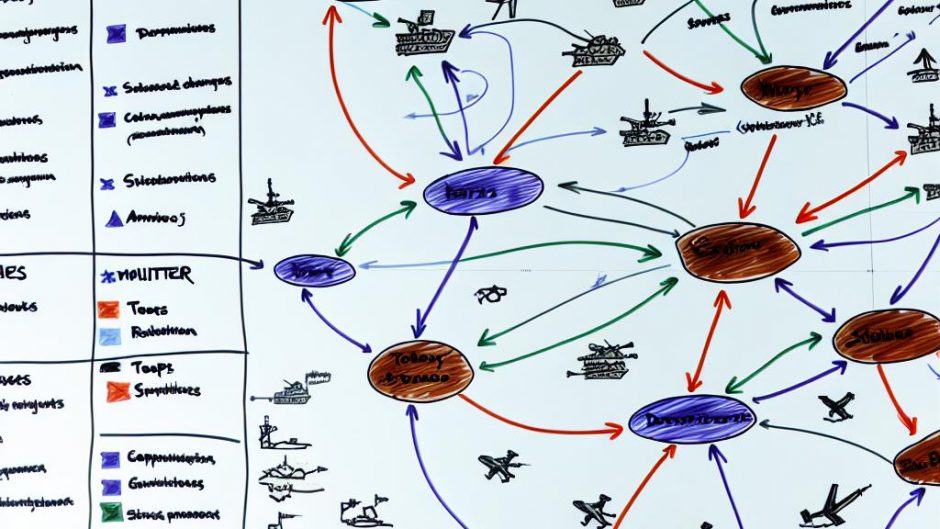Strategies for Coordinating Multiple Fronts
Managing numerous fronts in large-scale military conflicts necessitates a strategic approach designed to ensure seamless coordination across various areas of operation. This coordination relies heavily on effective leadership and communication, playing a pivotal role in preventing chaos and optimizing efficiency.
Effective Communication and Leadership
Communication serves as the cornerstone of military operations, particularly when overseeing multiple fronts. It is paramount for commanders to maintain open lines of communication with their subordinates to facilitate the rapid exchange of critical information.
Chain of Command: Establishing a clear chain of command is crucial for maintaining order and discipline within the ranks. Commanders must communicate expectations clearly, ensuring that every level of the hierarchy understands its designated role and responsibilities. This clarity helps prevent misunderstandings and promotes a harmonious execution of duties.
Real-Time Updates: The utilization of advanced technology and communication tools can provide timely updates, allowing commanders to make informed decisions promptly. This instant access to information enables decision-makers to adapt strategies rapidly based on real-time developments on the ground.
Resource Allocation and Logistics
Efficient resource allocation and logistics are indispensable for sustaining operational effectiveness across numerous fronts.
Sufficient Supply Lines: The provision of necessary resources such as food, ammunition, and medical supplies to each front is critical. Logistics planners must devise robust strategies to secure sustained operations, ensuring uninterrupted support for the troops engaged in active conflict.
Prioritization of Assets: Commanders should continuously assess the situation on each front to identify where assets and reinforcements are most urgently required. This involves making informed decisions about the deployment of resources, recognizing potential risks, and adjusting priorities accordingly.
Adapting to Dynamic Battlefields
Warfare is inherently dynamic, and success often hinges on a commander’s ability to exhibit flexibility and adaptability. This necessitates a readiness to revise strategies as conditions evolve.
Flexibility in Strategy: Developing flexible operational plans is vital for accommodating unforeseen circumstances. The implementation of contingency plans ensures that forces can swiftly adjust to changes in enemy tactics or environmental conditions, maintaining their operational edge.
Intel and Reconnaissance: Effective reconnaissance and intelligence gathering provide a strategic advantage. Regular frontline reports are instrumental in adapting strategies, refining approaches, and anticipating enemy maneuvers, contributing to more informed decision-making processes.
Importance of Morale and Psychological Warfare
Preserving troop morale is a critical element that can significantly impact the outcomes of multi-front conflicts.
Boosting Morale: Regular interaction with troops, acknowledging their contributions, and incorporating rest periods can play a pivotal role in maintaining high morale. It is essential for leaders to visibly demonstrate concern for the well-being and welfare of their forces, fostering a sense of camaraderie and mutual respect.
Psychological Operations: Employing psychological tactics to diminish enemy morale while fortifying one’s own forces’ resolve is a strategic advantage. This can include media operations, strategic information campaigns, and other psychological tools designed to weaken the enemy’s resolve and bolster confidence among friendly forces.
Leveraging International Alliances
The formation and maintenance of international alliances can substantially enhance operational capabilities.
Coalition Operations: Collaborating with allies allows for the sharing of resources, intelligence, and best practices, alleviating some of the pressures associated with managing multiple fronts. Multi-national forces can bring diverse capabilities and perspectives to the operations, enriching strategic and tactical planning.
Diplomatic Engagements: Maintaining diplomatic relations and open communication with allied nations are crucial for ensuring continued support and commitment to shared objectives. This fosters a unified approach and reinforces the alliance’s strategic goals.
In conclusion, managing multiple fronts during large-scale wars necessitates comprehensive planning, decisive leadership, and the ability to adapt to ever-changing environments. By concentrating efforts on effective communication, resource management, adaptability, morale, and international collaboration, military leaders can significantly increase their odds of success in extensive military engagements.
This article was last updated on: August 26, 2025






Recent Comments